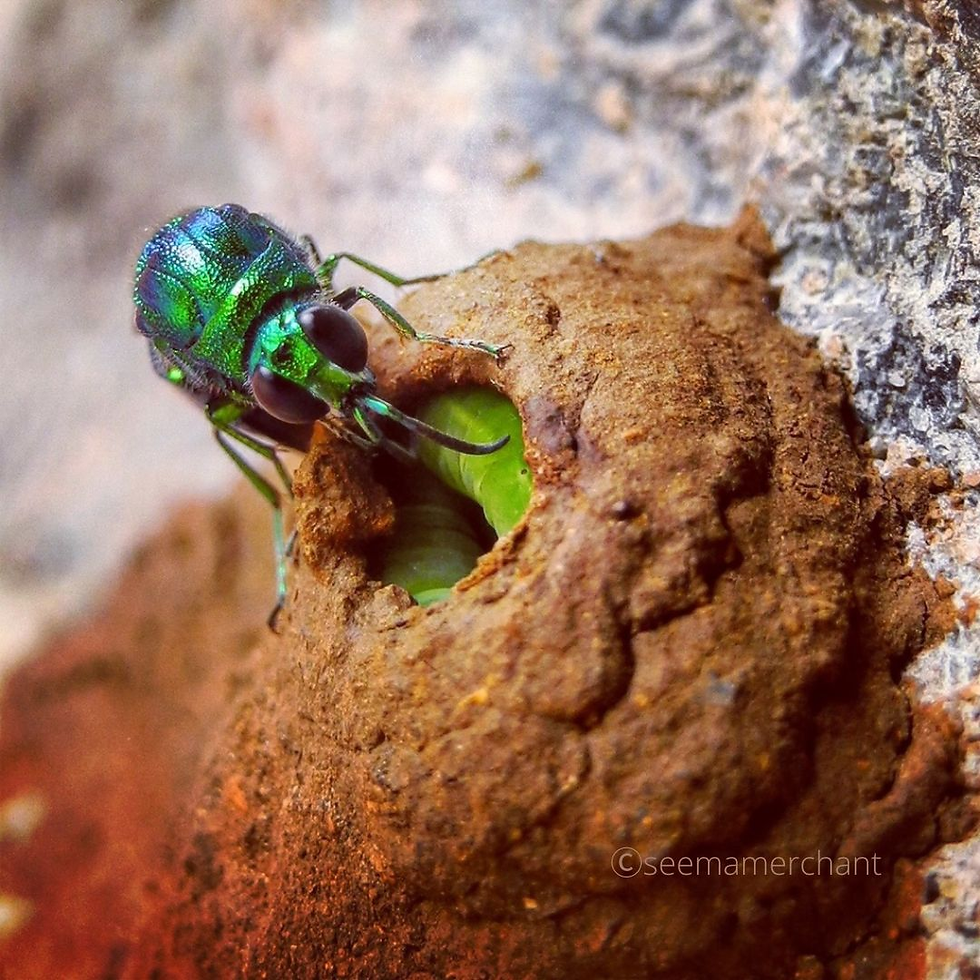Specimen Showcase | The Cuckoo Wasps
- Hong Kong Biodiversity Museum

- Mar 10
- 4 min read
Wasps🐝are often represented as social insects living with their sisters and mother within a large carton-made nest; ready to fly and sting any intruders adventuring too close to their home like a buzzing military army. This representation, however, is misleading (many species are actually rather mellow) because among the 110,000 wasp species described around the world, the characteristics of social wasps only applies to about 1100 species, thus just about 1% of all wasps. Then, what are the other wasps like? With such species richness, entire books are required to describe all their ecological diversity and the amazing biology encountered in wasps. But, here let us give you a teaser with a species named 𝘚𝘵𝘪𝘭𝘣𝘶𝘮 𝘤𝘺𝘢𝘯𝘶𝘳𝘶𝘮 (Forster, 1771), also commonly known as the large cuckoo wasp. This species doesn’t live with a big family, it doesn’t build a nest, and most of the time it’s not aggressive😚(not to us anyway).

𝘚𝘵𝘪𝘭𝘣𝘶𝘮 𝘤𝘺𝘢𝘯𝘶𝘳𝘶𝘮 is widely distributed across the warmer regions of Asia, Africa, Europe, and can also be found in Hong Kong. It belongs to the wasps family Chrysididae, which is commonly known as the cuckoo wasps. The adult cuckoo wasps mainly feed on nectar and their astonishing metallic colours💚on their bodies make them easily stand out from other wasps and bees (except maybe euglossine bees that are spectacular - just Google it but only after finishing reading this). However, what’s really special about cuckoo wasps is their parenting strategy👶🏻, which is also the reason why they are named after the cuckoo birds. Does that give you a hint?
Cuckoo wasps never build their own nests but instead lay their eggs into other insects’ nests. Their larvae will then consume the host’s eggs and the food stored in the nest, so the mother doesn’t have to worry about the child-raising business. This kind of behaviour is known as kleptoparasitism, meaning parasitism by stealing food. Most cuckoo wasps look for mud-nesting solitary wasps as their hosts, with some of them even developing highly specialised mechanisms to invade their hosts’ nests.

After mating, female 𝘚. 𝘤𝘺𝘢𝘯𝘶𝘳𝘶𝘮 are usually seen spying on a solitary wasp’s nest🐝until the female leaves to forage. She will then sneak onto the nest and start digging a hole on the surface with her mouthparts. After digging a hole, she turns around and inserts her ovipositor (the term for the egg-laying apparatus present at the tip of the abdomen) to lay eggs inside the nest. The cuckoo wasp will finally seal up the opening after oviposition and her larva will soon hatch to enjoy the big meal😋that was initially provisioned by the host female for her own brood.


Other species in the Chrysididae family may use different strategies to lay their eggs. For instance, some species will lay their eggs directly on the host’s prey, so the eggs will be brought back to the nest by the female host itself. Thus saving the cuckoo wasp female the effort of digging the nest and of a potential encounter with an angry mom. No one would like to face that, right? Some other cuckoo wasps species mimic the “odour” (or cuticular compounds) of their hosts to prevent detection or leaving any chemical traces when they sneak into the nest. All these mechanisms have evolved to prevent confrontation with the host, but this may not always be the case and a more confrontational💪🏻strategy is then preferred.
Instead of waiting for the host to leave, two 𝘚. 𝘤𝘺𝘢𝘯𝘶𝘳𝘶𝘮 individuals were observed to attack a wasp nest at the same time😱. While the host wasp is busy dealing with the first of the two cuckoo wasps, the second sneaks into the nest to lay her eggs. It is actually very rare to see two cuckoo wasps working together and being this aggressive, since most of the time they prefer working alone.

In fact, female cuckoo wasps don't have a stinger💉since they have retained their ovipositor (in wasp evolution, the stinger observed in a group known as the Aculeata and that include ants, bees and some wasps is actually a modified ovipositor which has changed from its initial reproductive function) and they may thus seem rather defenceless. Then how can they directly attack a wasp nest? Don't worry, most cuckoo wasps have a trick here: if you don’t have a good offence make sure to get a great defence. And that’s exactly what cuckoo wasps possess, with a highly sclerotised (hardened protein), rigid exoskeleton which acts as a heavy armour, and a concave abdomen which allows them to curl into a ball🎾like pangolins to protect themselves when they have to confront an angry host. Their cuticule is so hard that more than one entomologist has bent or broken their stainless pins while trying to prepare preserved specimens of cuckoo wasps.

So next time you find a nest wasp, have a good look around to spot these beautiful sneaky wasps trying to get in. If you are out of luck, the good news is that we have some for you to enjoy and learn about at the Hong Kong Biodiversity Museum!
Text: Arthur Lai




Comments